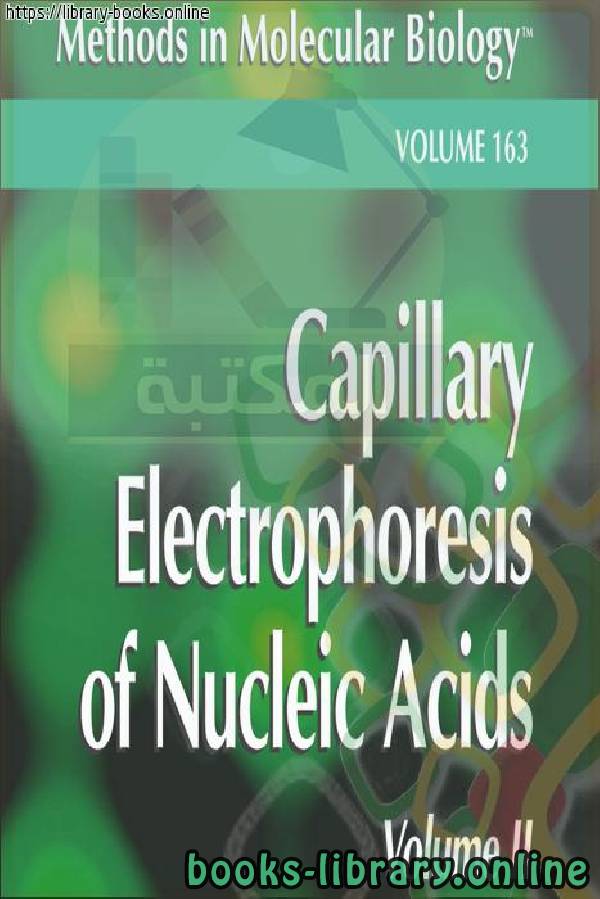📘 قراءة كتاب (Capillary Electrophoresis of Nucleic Acids Volume II Practical App أونلاين


Biologically
Biology is a natural science that is concerned with the study of life, its various forms and its function, how these organisms interact with each other and with the surrounding environment. The word biology in Greek is made up of two words: bio (βίος) meaning life. And loggia (-λογία) means science or study. Biology: the similarity of vegetation and animal cover on the edges of the African and American states, and the existence of the same fossil.
Branches of biology
Biology is an ancient science thousands of years old and modern biology began in the nineteenth century. This science has multiple branches. Among them are:
Anatomy
Botany
Biochemia
Biogeography
Biofisia
Cytology or cell science
Ecology or environmental science
نبذه عن الكتاب:
1. Introduction
Since the first descriptions of electrophoresis in small diameter tubes in the 1970s and
1980s (1,2), capillary electrophoresis (CE) has been recognized for its potential to replace
slab-gel electrophoresis for the analysis of nucleic acids (3,4). In particular, the availability
of commercial instrumentation for CE over the last several years has made both the size
determination and quantitation of DNA restriction fragments or polymerase chain reaction
(PCR) products amenable to automation. Due to the same charge-to-mass ratio, the electrophoretic mobility of nucleic acid molecules in free solution is largely independent of
their molecular size (5). Therefore, a sieving medium is required for the electrophoretic
analysis of DNA fragments based on their size. Typically, two different principal types of
separation matrix are used. The first type of matrix is of high viscosity polymer (e.g.,
polyacrylamide) with a well-defined crosslinked gel in regard to the structure and size of
its pores. The second type of matrix is a noncrosslinked linear polymer network of materials such as, linear polyacrylamide, agarose, cellulose, dextran, poly(ethylene oxide), with
lower viscosity than the former type and with a more dynamic pore structure. Although the
first type of matrix is attached covalently to the capillary wall and may provide better
separation for small (sequencing) fragments, the second matrix format has the advantage
of being able to be replenished after each electrophoretic cycle. This typically extends the
lifetime of a capillary, prevents contamination of the system, avoids sample carryover and
allows the use of temperatures well above room temperature. Most matrices used in both
systems are tolerant to the addition of DNA denaturants. Many different media useful for
the separation of DNA have now become commercially available (6).
In summary, the application of CE for DNA related research is attractive for
numerous reasons:
1. The high degree of automation avoids cumbersome gel pouring and sample loading.
2. High mass sensitivity eliminates the need to label DNA with carcinogenic stains, or with
radioactive DNA precursors
Biology
Human biology
Who is the founder of biology?
The importance of biology
Areas of work in the field of biology
Theories of biology
Research on biology for the first grade of secondary school
Human biology
حجم الكتاب عند التحميل : 3.037 .
نوع الكتاب : pdf.
عداد القراءة:
اذا اعجبك الكتاب فضلاً اضغط على أعجبني و يمكنك تحميله من هنا:

شكرًا لمساهمتكم
شكراً لمساهمتكم معنا في الإرتقاء بمستوى المكتبة ، يمكنكم االتبليغ عن اخطاء او سوء اختيار للكتب وتصنيفها ومحتواها ، أو كتاب يُمنع نشره ، او محمي بحقوق طبع ونشر ، فضلاً قم بالتبليغ عن الكتاب المُخالف:
 قبل تحميل الكتاب ..
قبل تحميل الكتاب ..
يجب ان يتوفر لديكم برنامج تشغيل وقراءة ملفات pdf
يمكن تحميلة من هنا 'http://get.adobe.com/reader/'


 منصّة المكتبة
منصّة المكتبة 